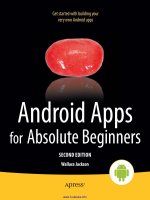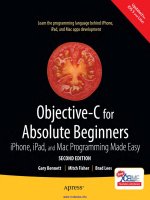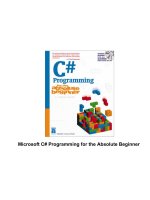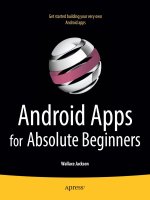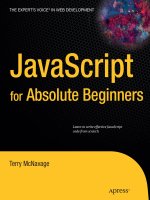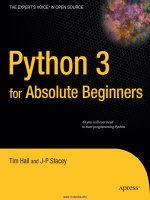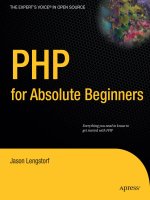python 3 for absolute beginners
Bạn đang xem bản rút gọn của tài liệu. Xem và tải ngay bản đầy đủ của tài liệu tại đây (8.3 MB, 314 trang )
The eXperT’s VoiCe
®
in open sourCe
for Absolute Beginners
Tim Hall and J-P Stacey
All you will ever need
to start programming Python
Python 3
www.it-ebooks.info
www.it-ebooks.info
Python 3 for Absolute
Beginners
■ ■ ■
Tim Hall and J-P Stacey
www.it-ebooks.info
Python 3 for Absolute Beginners
Copyright © 2009 by Tim Hall and J-P Stacey
All rights reserved. No part of this work may be reproduced or transmitted in any form or by any means,
electronic or mechanical, including photocopying, recording, or by any information storage or retrieval
system, without the prior written permission of the copyright owner and the publisher.
ISBN-13
(pbk): 978-1-4302-1632-2
ISBN-13 (electronic): 978-1-4302-1633-9
Printed and bound in the United States of America 9 8 7 6 5 4 3 2 1
Trademarked names may appear in this book. Rather than use a trademark symbol with every
occurrence of a trademarked name, we use the names only in an editorial fashion and to the benefit of
the trademark owner, with no intention of infringement of the trademark.
Lead Editor: Matthew Moodie
Technical Reviewer: Duncan Parkes
Additional material: Dr. J. Burton Browning
Editorial Board: Clay Andres, Steve Anglin, Mark Beckner, Ewan Buckingham, Tony Campbell, Gary
Cornell, Jonathan Gennick, Michelle Lowman, Matthew Moodie, Jeffrey Pepper, Frank
Pohlmann, Ben Renow-Clarke, Dominic Shakeshaft, Matt Wade, Tom Welsh
Project Managers: Beth Christmas and Debra Kelly
Copy Editor: Heather Lang
Compositor: LaurelTech
Indexer: BIM Indexing and e-Services
Artist: April Milne
Distributed to the book trade worldwide by Springer-Verlag New York, Inc., 233 Spring Street, 6th Floor,
New York, NY 10013. Phone 1-800-SPRINGER, fax 201-348-4505, e-mail , or
visit .
For information on translations, please e-mail , or visit .
Apress and friends of ED books may be purchased in bulk for academic, corporate, or promotional use.
eBook versions and licenses are also available for most titles. For more information, reference our
Special Bulk Sales–eBook Licensing web page at
The information in this book is distributed on an “as is” basis, without warranty. Although every
precaution has been taken in the preparation of this work, neither the author(s) nor Apress shall have
any liability to any person or entity with respect to any loss or damage caused or alleged to be caused
directly or indirectly by the information contained in this work.
The source code for this book is available to readers at .
www.it-ebooks.info
iii
Contents at a Glance
■Contents v
■About the Author xi
■About the Technical Reviewer xii
■Chapter 1: Introducing Python 1
■Chapter 2: Designing Software 9
■Chapter 3: Variables and Data Types 27
■Chapter 4: Making Choices 49
■Chapter 5: Using Lists 75
■Chapter 6: Functions 101
■Chapter 7: Working with Text 125
■Chapter 8: Executable Files, Organization, and Python on the Web 161
■Chapter 9: Classes 181
■Chapter 10: Exceptions 221
■Chapter 11: Reusing Code with Modules and Packages 241
■Chapter 12: Simple Windowed Applications 261
■Index 283
www.it-ebooks.info
www.it-ebooks.info
v
Contents
■About the Author xi
■About the Technical Reviewer xii
■Chapter 1: Introducing Python 1
Running Python on Various Systems 1
Learning While Having Fun 4
Introducing the Interactive Shell 4
Choosing to Code with a Text Editor 5
Choosing to Code with an Integrated Development Environment 5
Getting Started with Programming 5
Creating Your Own Help Files 6
Jargon Busting 6
Summary 7
■Chapter 2: Designing Software 9
Designing Your Own Software (Why Bother?) 9
Identifying the Problem 10
Creating Your Wish List 12
Devising a Solution 13
Breaking Down the Solution into Steps 15
Jargon Busting 24
Summary 25
■Chapter 3: Variables and Data Types 27
Choosing Good Identifiers 27
Creating Variables and Assigning Values 28
Recognizing Different Types of Variables 29
Jargon Busting 45
www.it-ebooks.info
■ CONTENTS
vi
Summary 47
■Chapter 4: Making Choices 49
Comparing Things 49
Taking Control of the Process 55
Dealing with Logical Errors 57
Using Conditional Code in the Application 61
Now Repeat That 65
Jargon Busting 73
Summary 74
■Chapter 5: Using Lists 75
Working with Python Data Structures 75
Tuples 79
Lists 80
Sets 85
Dictionaries 86
A Simple Role-Playing Combat Game 89
Jargon Busting 99
Summary 100
■Chapter 6: Functions 101
Accessing Privileged Information 101
Working with Variable Scope 105
Refactoring rpcombat.py to Reduce Repetition 108
Jargon Busting 123
Summary 124
■Chapter 7: Working with Text 125
Strings and Things 125
Matching Patterns Using Regular Expressions 135
Using Files 141
Applications 145
Jargon Busting 159
Summary 160
www.it-ebooks.info
■ CONTENTS
vii
■Chapter 8: Executable Files, Organization, and Python on the Web 161
Making Programs Executable as Stand-Alone Applications 161
Organizing Your Project 164
Writing Stylish Code 165
Importing Modules 170
Using exec() and eval() 172
Putting Python on the Web 173
Jargon Busting 179
Summary 179
■Chapter 9: Classes 181
Empowering objects 182
When Should Classes Be Used? 185
Customizing Classes 191
Application 200
Jargon Busting 219
Summary 220
■Chapter 10: Exceptions 221
When Something Goes Wrong 221
Classes of Exceptions 224
A Final Note on Pythonic Exception Handling 238
Jargon Busting 239
Summary 240
■Chapter 11: Reusing Code with Modules and Packages 241
Understanding Python Modules 241
Everyday Module Usage 244
Advanced Module Behavior 249
Combining Modules into Packages 252
The Universe of Python packages 254
Jargon Busting 259
Summary 260
www.it-ebooks.info
■ CONTENTS
viii
■Chapter 12: Simple Windowed Applications 261
Using Tkinter 261
Saying “Hello” with PyGTK 265
Using Glade and tepache to Build Interfaces 279
Jargon Busting 282
Summary 282
■Index 283
www.it-ebooks.info
ix
About the Author
■Tim Hall currently provides front—line support for 64 Studio. He has also written
newbie tutorials for Linux User and Developer magazine in between more
mundane system admin and web authoring jobs.
Tim has released albums and performed as a musician and songwriter, both
solo and in collaboration with other artists. He has been further honored as the
holder of the Bardic chair of Glastonbury between 2005 and 2007. Tim uses
Python as his main programming language, primarily as a means for creative
ends, because it is easy to read and fun to learn.
J-P Stacey has been a senior developer at Torchbox Ltd since 2005, building and maintaining
(among other things) Python, Django, and Drupal applications.
He organizes the Oxford Geek Nights and gets involved in tuition and seminars at Torchbox. In his
spare time he reads and writes fiction and blogs, buys too much music, and tries not to startle Cotswold
lions on his bicycle.
www.it-ebooks.info
www.it-ebooks.info
xi
About the Technical Reviewer
■Duncan Parkes has been coding in Python, both for work and for fun, for roughly
a decade. He drifted into programming largely by accident after initially taking a
doctorate in Combinatorial Group Theory, a branch of Pure Mathematics. As an
ex-mathematician, he loves the clarity and simplicity of Python and needs a bit of
persuading to code in anything else. After completing a technical review of this
book, he joined Apress as an editor in the Open Source group. He currently splits
his time between editing books and coding for mySociety, a charitable
organization that runs most of the UK's best-known democracy web sites.
Duncan lives in Oxford, England, with his wife, Ruth. When away from his
computer, Duncan enjoys playing the guitar very badly, cycling long distances on a
Brompton folding bicycle, and fiddling with old cars.
His friends and colleagues have been known to run sweepstakes on how far these vehicles can get
without the assistance of a breakdown service.
www.it-ebooks.info
www.it-ebooks.info
C H A P T E R 1
■ ■ ■
1
Introducing Python
So, you want to learn programming. Welcome to one of the great adventures of the twenty-first century.
Programming requires little in the way of specialized equipment; the software tools can all be
downloaded for free off the Internet, and it can be practiced in the safety and comfort of your own home,
without having to ask anyone’s permission. This chapter will ease you in gently by introducing you to the
software you will need to create your programs: a command-line interface, which allows you to use
Python in interactive mode, and a text editor for writing scripts—nothing more complicated than that. I
will also show you where to go to find help and documentation, so you can decode the sometimes-
impenetrable jargon that seems to surround this, the geekiest of all technical disciplines. To begin with,
you will need to make sure that you have a decently recent version of Python installed on your machine
or follow the steps later in this chapter to install it (see “Choosing the Right Python Version” for a
definition of decently recent). This chapter explains how to make sure that you have everything set up
correctly and that you have suitable references at hand before you start your journey.
Python is an excellent language with which to learn programming. There are many reasons for this,
but the simple explanation is that it’s easy to read and fast to write; it doesn’t take long to come up with
working code that does something meaningful. Python has a very human-friendly syntax, which makes
writing elegant code easy. The basic language is fairly simple and therefore easy to remember, and then
it has an extensive library of predefined functions that you can use to facilitate most common computer
tasks. Writing effective applications in Python can be as simple as playing with conceptual building
blocks. It works really well for writing a little two-line application to perform some routine system
administration task or to provide interactive functions on a web page, but it has enough power and
flexibility to comfortably create much larger and more complex applications with graphic interfaces
indistinguishable from the programs you are used to running from your computer’s main menu. If you
follow the suggestions laid out in this book about writing self-explanatory code, in several months, even
years, you will be able to come back to your programs and see immediately what they were supposed to
do and what your original intentions were; this makes maintaining programs much simpler too.
OK, let’s make sure your system is ready for you to start running Python programs.
Running Python on Various Systems
Python can be installed and run on most operating systems including Windows, Mac OS X, or OS/2,
Linux, and Unix. If you are running Mac OS X or a GNU/Linux system, you will probably have it installed
by default. I would recommend using a system of this kind, which already has Python set up as an
integral part. The book was written using a Debian GNU/Linux system, and therefore, the examples will
www.it-ebooks.info
CHAPTER 1 ■ INTRODUCING PYTHON
2
work exactly the same on any Debian-based system, such as Ubuntu. In fact, the differences between
Linux variants are few, so you’ll be equally at home with other distributions.
Installing on Windows
If you are using Windows, you will probably have to install Python and configure certain settings
correctly before you can get to grips with the examples in this book. For that, you will need to refer to the
specific instructions for your operating system on the following Python web pages:
•
•
•
First, you need to download the official installer; alternative versions for Itanium and AMD
machines are available from You should save this file, which will
have a .msi extension, somewhere you’ll be able to find again easily. You can then double-click this file
to start the Python installation wizard, which will take you through the installation. It’s fine to accept the
default settings if you’re not sure of any answer.
Installing on Other Systems
You may choose to install Python on other systems, particularly if you want to take advantage of newer
versions. For Linux and other Unix-like systems, the installation instructions are here:
•
If you’re using OS X, your instructions are here:
•
•
Choosing the Right Python Version
You will find the different installers include a number after the word Python. This is the version number.
When I started writing this book, those numbers ranged from 2.3.7 (old but still usable) through 2.5.2
(the previous stable version) to 3.0 (the new version about to be released). At the same time as version
3.0 was released, the Python team also put out version 2.6, which is an upgraded version of Python
version 2 for people who want (or need) to stick with the old way of doing things but still want to benefit
from general fixes and some of the new features introduced in version 3.0.
The Python language is continuously evolving; version 3.0 has become the norm and has evolved
into version 3.1.1. The new version, which I’ll refer to as version 3.0 because all 3.x versions are simply
refinements on the original plan of 3.0, includes several changes to the programming language that are
incompatible with version 2.x (x is any number you like), which I will refer to in the rest of this book as
the old version. Most of the language is the same, however, so the differences between the versions of
Python will be noted in the text as those subjects are covered. Examples in this book are for Python 3.0
except where noted.
www.it-ebooks.info
CHAPTER 1 ■ INTRODUCING PYTHON
3
Further information about the latest version of Python 3.0 (also known as Py3k or Python 3000) is
available at
There may be some differences running Python on other operating systems, which I will do my best
to point out where relevant. Otherwise, the examples of code will work the same way. This is one of the
many good points of Python. For the most part, this book will concentrate on the fun part—learning how
to write programs using Python. The official Python documentation is plentiful, free, and well written,
and you should read it alongside this book. It is available on at
Understanding the Jargon
Throughout this book, I will be doing my best to demystify, clarify and explain the various bits of technical
terminology that you will frequently encounter during the process of learning the art of programming.
Technical terms and jargon words that need further explanation will be highlighted in bold the first time
you encounter them. Any terms not immediately explained in the chapter will be covered in the “Jargon
Busting” section at the end of each chapter. You may also wish to study one of the most famous resources
on the Internet, the Jargon File, which is part of the New Hacker’s Dictionary (available at
As an example, here’s the definition of the noun “code” from the Jargon File:
“The stuff that software writers write, either in source form or after translation by a compiler or assembler.
Often used in opposition to ‘data,’ which is the stuff that code operates on. Among hackers this is a mass
noun, as in ‘How much code does it take to do a “bubble sort”?’ or ‘The code is loaded at the high end of
RAM.’ Among scientific programmers, it is sometimes a count noun equivalent to ‘program;’ thus they may
speak of ‘codes’ in the plural. Anyone referring to software as ‘the software codes’ is probably a ‘newbie’
or a ‘suit’.”
For comparison’s sake, here’s the definition of the verb “code”:
“To write code. In this sense, always refers to source code rather than compiled. ‘I coded an Emacs clone
in two hours!’ This verb is a bit of a cultural marker associated with the Unix and minicomputer traditions
(and lately Linux); people within that culture prefer v. ‘code’ to v. ‘program,’ whereas outside it, the reverse
is normally true.”
The noun “program” is defined as being:
• “A magic spell cast over a computer allowing it to turn one’s input into error
messages”
• “An exercise in experimental epistemology”
• “A form of art, ostensibly intended for the instruction of computers, which is
nevertheless almost inevitably a failure if other programmers can’t understand it”
As the information contained in the Jargon File is more entertaining than strictly informative, I will be
providing some simpler definitions at the end of each chapter.
www.it-ebooks.info
CHAPTER 1 ■ INTRODUCING PYTHON
4
Learning While Having Fun
Having fun is often underestimated in the realm of technical disciplines. We learn best and are most
productive when we’re having fun. Developing software using Python is often an engrossing and
enjoyable experience, partly because you can test out your changes as soon as you have made them
without having to perform any intermediary steps.
Python also deals with many background tasks, the household chores of programming, so you don’t
have to bother with them as you might in languages like C. This kind of immediate gratification makes it
easier to stay in the creative flow and keep being inspired.
Python is also easy to read, being closer to natural language than many other programming
languages, so you spend less time trying to decode what you have just written, which in turn means
more time to think about how you could improve and expand your work.
The other great thing is that you can use Python for pretty much any task you can think of, be it large
or small, simple text-driven script or major graphical application. It does have its limitations, but by the
time you come up against them, you will already have become a competent programmer and will be
able to make an informed choice about where to go next.
Introducing the Interactive Shell
Although this book is primarily aimed at showing you how to write stand-alone scripts and
applications—that is, fully fledged programs that don’t require anything other than having Python
installed for them to work—Python also works in interactive mode, which allows you to enter Python
commands using a command-line interface. This is a great resource for immediate Python gratification.
You need to locate and start up your computer’s command-line interface, sometimes known as the
terminal or terminal emulator, or on machines running Windows, the DOS prompt. This will provide
you with a command line at which you can start typing commands. Interactive mode can be started up
by typing python at the command line. If Python is properly installed, you should see something like this:
$ python
Python 3.1.1 (r311:74483, Aug 17 2009, 17:02:12)
[GCC 4.2.3 (Debian 4.2.3-5)] on linux2
Type "help", "copyright", "credits" or "license" for more information.
>>>
The details may be different according to your operating system. The first line shows the Python
version number and the compilation date of the version you have installed. The last line (>>>) is your
Python prompt. This indicates that the Python interpreter is running and waiting for your input. The
Python interpreter is the program that reads Python programs and carries out their instructions.
Interactive mode can be useful for testing out individual commands line by line, experimenting with
new ideas, and getting help (try typing help(), and don’t forget the parentheses; they are important). To
get out of the interactive Python interpreter on a Linux system, you can use the quit() or exit()
functions, or else you must hold down the Ctrl key and the D key at the same time (in Windows, you
need to use Ctrl+Z and then press Enter).
www.it-ebooks.info
CHAPTER 1 ■ INTRODUCING PYTHON
5
Choosing to Code with a Text Editor
My preferred method of creating Python scripts is to use a plain text editor, with a few basic
programming features. Programs like notepad (especially notepad2/++), BBedit, gedit, NEdit and Kate
are ideal for this task. A variety of editors are available that offer specific enhancements for
programmers, such as syntax highlighting, which is useful for showing coding errors immediately as you
type. Old-school hackers may prefer to use Vi or Emacs. Python does not dictate what software you use
to create the code; the choice is up to you. Do not attempt to use word-processing software, such as
Word or OpenOffice for this task; it will mess you up badly. Be warned!
Choosing to Code with an Integrated Development
Environment
An integrated development environment (IDE) is a graphical interface with lots of useful features
designed to make programming with Python even easier. You still have to type the code in the same way,
but you can do all your coding using a single application, and these programming environments can
provide some useful shortcuts and reminders. There are now several Python-specific IDEs. Popular
applications include IDLE (which is bundled with Python itself), Eric (you may notice a theme here,
nudge nudge, wink wink, say no more ), Geany, DrPython, and SPE. Python is also supported by more
general programming environments like Bluefish and a whole host of others. This book doesn’t cover
the use of IDEs or any of the alternative distributions of Python, because each of these approaches
would require a chapter unto themselves, at the very least. However, the examples contained in this
book will still work if you do choose to explore these options. This book will take the simplest approach,
using tools that come as standard with most operating systems; that is, a text editor and the Python
Interactive Shell.
Getting Started with Programming
The process of writing a new program usually starts with a problem. Before you can code anything, you
need to have an idea of what you want to create, the problem you wish to solve, and a fairly good idea of
how to solve it. Chapter 2 will take you through the process of designing software, known as the software
development cycle. Usually, this is something that you have to learn separately, as most programming
manuals go straight into the details of the language, assuming you will have studied program design at
college or in the process of learning some other programming language. This can lead you to create code
that is difficult to read and understand and makes fixing problems later a nightmare. Understanding the
principles of software design can dramatically speed up the process of creating new software and help
ensure that important details are not missed out.
In Chapter 3, you start coding those designs in Python. You will learn about constructing the basic
units of data, words and numbers, and how to combine and manipulate them. In Chapter 4, I will show
you how to compare values, make choices, and deal with errors. The subsequent chapters go through
the process of refining those designs, breaking them down into manageable chunks, and expanding your
understanding of the Python programming language so you can turn your ideas into fully fledged,
functional computer programs.
www.it-ebooks.info
CHAPTER 1 ■ INTRODUCING PYTHON
6
Creating Your Own Help Files
Python is described as self-documenting. This doesn’t mean that it will write your user manual for you,
but you can add blocks of text, known as documentation strings, to your own code, and these strings
will then show up in an online help utility. This information can easily be turned into web pages to
provide a useful reference. I will show you how to do this in Chapter 2; it is one of the unique features of
Python and is worth learning how to use early on.
Jargon Busting
This chapter introduced several technical terms with which you may not be familiar, these are defined as
follows:
• Command-line interface (CLI): This mechanism is for interacting with a computer
by typing in commands to a text-based interface such as the terminal or DOS prompt.
• Compile: This process turns a sequence of instructions in programming language,
which is readable by humans (in theory) into machine code, which can be directly
executed by the computer. Python does this automatically in the background
when you run your script. In some other languages, this has to be done as a
separate step before you can execute the program.
• Documentation strings: This block of text on the first line of a function, module, class,
or method definition is also called a “docstring.” Docstrings are used by Python’s built-
in tools for automated testing and to provide help documentation. See Chapter 2.
• Interpreter: This program turns a sequence of instructions in a script into
something that a computer can execute on the fly, effectively compiling the code
as the program is running rather than as a separate step.
• Natural language: This is language that humans speak, as opposed to a
programming language.
• Operating system: This is the software component of a computer system that is
responsible for the management and coordination of activities and the sharing of
the resources of the computer. The operating system communicates between the
applications that are run on the machine and the machine’s hardware
components.
• Prompt: This visual cue tells the user to input something.
• Script and application: The terms “script,” “application,” and “program” are used
somewhat interchangeably in this book, though there are some subtle differences
in meaning:
• Script: This short but complete piece of code is intended to be run using an
interpreter. A script will exist as a text file that you can read.
• Application: This refers to any applied use of a programming language. It
usually means a complete, packaged-up, and usable piece of software. It is
the preferred term among Linux/Unix users.
www.it-ebooks.info
CHAPTER 1 ■ INTRODUCING PYTHON
7
• Program: This refers to the sequence of instructions involved in a script or
application; it is also used as a general term to describe an executable
computer file.
• Software development cycle: In this structured approach to developing software,
each stage can be fed back into previous stages. See Chapter 2.
• Version number: This number corresponds to a new development in a piece of
software. These numbers may refer to major or minor changes and are generally
assigned in increasing order. The method used for assigning these numbers is
referred to as a versioning system.
Summary
This chapter has explained some of the technical terms that you will encounter as you study the art of
programming and has introduced you to some sources of further information to help you as you grow in
understanding.
So far, you have made sure that the right version of Python is installed on your system and you know
how to get to the Python command prompt. You should have selected a text editor to use for writing and
saving your scripts, but you haven’t written any code yet. In the next chapter I will show you how to start
designing programs from the initial seed of a problem that you wish to solve.
www.it-ebooks.info
www.it-ebooks.info
C H A P T E R 2
■ ■ ■
9
Designing Software
If you are anything like me, you impatiently started reading this book at Chapter 3, became really
confused about halfway through, and decided to start at the beginning and read it all properly this time.
This chapter explains the bit that most manuals leave out: how to actually turn your problem into a
working program. The first stage of the software development cycle is the creation of a program design.
In this chapter, I’ll demonstrate how to break down your ideas into manageable chunks, understand
each problem that you are trying to solve, build up a sequence of actions, keep track of what you’ve
done, and above all, how to go about the constant refinement and simplification of your ideas that will
lead to an effective solution that is easy to understand. I’ll be introducing you to pseudocode, the
software design language, and showing you how to turn it into Python documentation strings to create a
framework around which you can grow an effective and maintainable piece of software.
Your first challenge, which I’ll be using as an example for this chapter, is to get the computer to
respond to a command and print out some kind of response—fairly basic stuff, which you could probably
guess at a solution for. However, it’s always good to start as we mean to go on, so I’m going to break this
down in terms of the software development cycle. In order to get off the starting blocks, it is necessary to
identify the problem through a process of asking the right questions and then begin developing a solution,
initially by creating a wish list of the things you want your new program to do and getting feedback from
potential users. You will use all this information to create your initial program design.
In the next part of this chapter, you will be able to start turning that design into working code. As
soon as the design is coded, you will want to begin refining and testing it, starting with defining the
results you expect to get and then figuring out how to detect and correct errors.
In the final stage of the software development cycle, you will discover how to use docstrings to
document the solution and see how this then feeds back into the next round of the development cycle.
Designing Your Own Software (Why Bother?)
There are many reasons that you might want to write your own software, the chief one being that the
applications you have available don’t do what you want in the way that you want. You may already have
an idea of something you wish to achieve, which led you to pick up this book in the first place. Perhaps
you need a solution for work; maybe you have a killer game idea that you’d like to realize; you might
want to organize some data in a web page or perform some system administration task. You might want
to control a gadget you just built or automate any number of repetitive jobs. Possibly, you already have
the program you need, if only it would do this one extra thing, or maybe you just enjoy the idea that
writing your own software is possible. I’m not going to try to tell you why you should want to get
involved in this peculiar sport; I’ll assume you have worked that out for yourself already.
www.it-ebooks.info
CHAPTER 2 ■ DESIGNING SOFTWARE
10
Let’s start by asking some questions. Never be afraid to ask questions. Why bother doing all this?
Why not just go straight ahead and start writing code? Coming up with a clear design first, along with a
clear idea of what answers you expect to see, cuts down on a lot of wasted effort and makes your
programs easier to document, troubleshoot, and maintain. It is important to remember that you are
trying to make life easier—not more complicated—for yourself and others.
Asking the Right Questions
“Why bother?” is an important programming question that should be applied to every project, module,
function, or line of code before you begin. There is a strong possibility that someone, somewhere has
already written the software you need, or at least something very similar, that you could convert to your
needs with the addition of a couple of lines of code.
Close on its heels comes the next question, “Isn’t there a simpler way to do this?” Laziness is the
programmers’ ally; you probably won’t have to write very much from scratch, and you won’t need to
learn everything by heart before you begin. Generally speaking, you can look up most things as you go
along. The art of programming has much more to do with figuring out a logical procedure to get
something done than memorizing lines of code; indeed, one of the most common practices involved in
coding is simplification. Your first task is about as simple as it gets, but as the book progresses, you will
be facing much more complex problems as well as coming up with ideas of your own.
Using Python to Solve Problems
Python is similar in style to pseudocode, the language programmers use to design software, with the
difference that you can run it on your computer and actually get results. It’s easy to read (being close to
English), fun to learn, and doesn’t require compiling, that is, you can run your script as soon as you have
saved it without having to perform any intermediate steps. Python is also a useful language in that it can be
used to deal with a wide range of problems with relative ease, and it has a good selection of preconstructed
modules to deal with many of the more common computer tasks. I find it similar to playing with
conceptual building blocks: the elements of the language are fairly simple to grasp, but they can be
combined in pretty much any way you can think of to create apparently complex and graceful structures.
One of the other great features of Python is that it is self-documenting. You still have to write the
documentation yourself, but you can include blocks of help text, known as documentation strings or
docstrings, within the structure of the program itself. I will be using this particular feature to keep all the
design ideas together in one file at the outset and allow us to think on paper. Subsequently, you will be
able to look back over old code and know what you were trying to achieve long after you have forgotten
why you wrote it in the first place. Eventually, these docstrings will be used to communicate how your
program works to other programmers.
Identifying the Problem
Before you start coding anything, you need to have an idea or a problem that you wish to solve. It is quite
useful to start with a familiar repetitive task that you suspect could be performed more efficiently using a
simple script. Your first problem is to find out how to communicate with your computer using Python
and how to get your computer to communicate back. Using this as an example, I will briefly explain the
stages of the software development cycle that most programs will go through in course of their
development. You don’t have to slavishly follow all the suggestions in this chapter, but you may find that
they provide a useful structure for developing more complex applications and to get you back on track if
www.it-ebooks.info
CHAPTER 2 ■ DESIGNING SOFTWARE
11
you find yourself getting lost. It is also useful to be able to design your program before having to think
about the details of coding it in a formal computer language.
The first stage of writing any new program is to grow a design out of the initial problem, a sequence
of actions that will calculate the correct result and create the required output. Once the idea has passed
the “Why bother?” test, it is necessary to create a simple framework on which to hang the various bits of
code that you come up with. Without such a framework, it is often difficult to know where to begin and
virtually impossible to construct anything but the simplest of scripts without it getting messy very
quickly. The great news is that no specialized knowledge is required at this stage. The process can be
started off by answering a few simple questions:
• What do you want the software to do?
• Who will be using it?
• What system will users be running it on?
What Do You Want the Software to Do?
Open a text editor, and write out what the problem is that you want to solve and, very briefly, what you
actually want the software to do. A simple text editor will do for this task (see Chapter 1). It’s best to start
with some simple jobs that you already know computers can do, like printing out a daft message, adding
up some numbers, or updating the prices of items in a catalog. Classically, half the battle is identifying
the problem, and once you have done so, the solution will begin to become clear. Save the file as plain
text (with the .txt extension) and give it the title of your program-to-be. The first program you’re going
to write later in this chapter will be called Hello World! It will be designed to solve the problem of getting
your computer to print out a friendly, affirmative or daft message when you ask it to, so you may as well
save this as hello world.txt.
■ Tip You might want to create a new directory to store all your Python experiments.
Who Will Be Using It?
Next, you need to specify who will be using the application, even if you’re just doing it for your own
personal gratification and no one is ever going to see the output. Write this down.
What other people will be using the program?
• Friends
• Relatives
• Work mates
• Registered users
• Anonymous clients that you’re never likely to meet
www.it-ebooks.info
